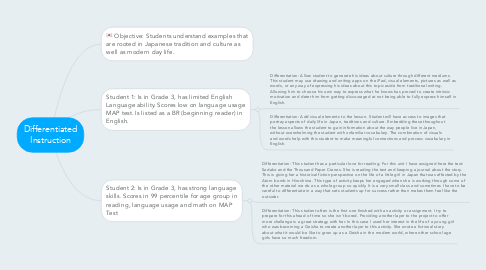Differentiated Instruction
by Megan Keach

1. Objective: Students understand examples that are rooted in Japanese tradition and culture as well as modern day life.
2. Student 1: Is in Grade 3, has limited English Language ability. Scores low on language usage MAP test. Is listed as a BR (beginning reader) in English.
2.1. Differentiation: Allow student to generate his ideas about culture through different mediums. This student may use drawing and writing apps on the iPad, visual elements, pictures as well as words, or any way of expressing his ideas about this topic aside from traditional writing. Allowing him to choose his own way to express what he knows has proved to create intrinsic motivation and deter him from getting discouraged at not being able to fully express himself in English.
2.2. Differentiation: Add visual elements to the lesson. Student will have access to images that portray aspects of daily life in Japan, traditions and culture. Embedding these throughout the lesson allows the student to gain information about the way people live in Japan, without overwhelming the student with unfamiliar vocabulary. The combination of visuals and words help with this student to make meaningful connections and process vocabulary in English.
3. Student 2: Is in Grade 3, has strong language skills. Scores in 99 percentile for age group in reading, language usage and math on MAP Test
3.1. Differentiation: This student has a particular love for reading. For this unit I have assigned here the text: Sadako and the Thousand Paper Cranes. She is reading the text and keeping a journal about the story. This is giving her a historical fiction perspective on the life of a little girl in Japan that was effected by the Atom bomb in Hiroshima. This type of activity keeps her engaged when she is working through some of the other material we do as a whole group so quickly. It is a very small class and sometimes I have to be careful to differentiate in a way that sets students up for success rather than makes them feel like the outsider.
3.2. Differentiation: This student often is the first one finished with an activity or assignment. I try to prepare for this ahead of time so she isn't bored. Providing another layer to the project to offer more challenge is a great strategy with her. In this case I used her interest in the life of a young girl who was becoming a Geisha to create another layer to this activity. She wrote a fictional story about what it would be like to grow up as a Geisha in the modern world, where other school age girls have so much freedom.


